24th Annual Salary and Job Satisfaction Survey

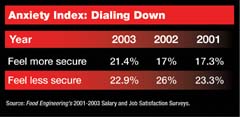
The 24th annual Food Engineering Salary and Job Satisfaction Survey paints a workforce portrait considerably more settled than the general economy's. Asked if their feelings of job security improved, worsened or stayed the same in the last year, respondents provided their most optimistic answers in years (see Anxiety Index: Dialing Down above). Salaries increased an average of 4.8 percent for those who received a pay boost, compared to 3.5 percent projected for all American workers in a WorldatWork survey of human-resources directors. With the Consumer Price Index increasing a modest 2.2 percent in the last 12 months, that leaves those food professionals with a healthy 2.6 percent boost in purchasing power.
Pay ranges also stack up nicely compared to professionals in other industries. More than a third of respondents-36 percent-are earning between $60,000 and $90,000, with another 17 percent in the $100,000 to $149,499 range. The median income of $75,000 compares to $56,326 in a U.S. Bureau of Labor Statistics study of occupational wages for engineers. The typical Food Engineering reader saw between $35 and $52 more in his weekly pay envelope than last year.
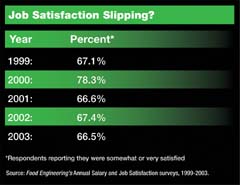
According to WorldatWork, a professional association of compensation and benefits executives that has tracked workforce salaries for 30 years, 83 percent of 15.8 million employees at 3,100 U.S. companies will receive pay hikes this year, but the 3.5 percent average increase is down considerably from the 4.1 percent projected a year ago. In 2002, 85 percent of Americans received raises. In 2001, the figure was 94 percent.
Though Food Engineering readers say their feelings of job security increased in 2003, they rated their level of security slightly lower than previous respondents. On a five-point scale, the average security rating was 3.75, down from 2002's 3.78 and 2001's 3.9. Job satisfaction ratings also slipped a bit to 3.77, from 3.81 in 2002 and 3.8 in 2001.
That may be a function of less job tenure among this year's respondents. Median years in the food industry remain at 19 years, but median years with current employer sank to seven, from eight in 2002 and 10 in 2001. Mobility is at its highest point in years, with 41 percent working five years or less with their current employers.
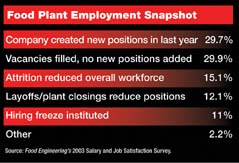
Bennies under pressure
Salary isn't the only financial dimension of work, and food professionals face the same pressures as the rest of the workforce when it comes to benefit packages. To get a measure of what is happening with insurance payments, bonuses and other benefits, readers were asked how those plans changed (see How Benefit Plans are Changing on page 34).Vacation and other time off are the most stable element of workers' benefit packages, with 85 percent reporting no change and more respondents experiencing positive adjustments than negative ones. Employer 401K plans are stable, though retirement benefits are being strained, with 11 percent of readers reporting reductions.
Medical and dental costs are skyrocketing, raising the likelihood employers will require higher contributions from employees. Almost two in five food professionals saw their medical insurance payments increase in the last year, and dental co-payments went up for a third of our respondents. Annual bonuses declined for three in 10 who enjoy such benefits (21 percent overall).
Reduced benefits and little or no pay increases are a prescription for dissatisfaction, and "poor pay" was a frequent reason cited by readers who were somewhat or very dissatisfied in their current positions. "Underpaid, under appreciated, little room to grow," wrote one. "High pressure and stress, low pay, low rewards, poor communication with management team and staff, politics, fear of layoffs, boredom," wrote another.

Good pay and challenging work characterize the comments of respondents who are somewhat or very satisfied. Several very satisfied workers mentioned company ethics. "Great company, wonderful co-workers," one respondent wrote. Offered another: "Growing company, ethical, employee oriented."
The freedom to do their jobs and the resources to do them effectively are appreciated by the most satisfied workers. Owning the company doesn't hurt, either, as nine respondents indicated. Great pay and good benefits were cited by some, but not nearly with the same frequency as low-pay citations by dissatisfied workers.
Three company owners were among the 172 somewhat satisfied respondents (42.3%). Their reasons for liking their jobs closely parallel the very satisfied, but many of them hint at serious concerns. "The pay is good, security is excellent, work is challenging, but there is little advancement opportunity," one wrote.
"Many people out of work; co-workers make the job bearable," said another. Everyone loves a winner, and when a company is growing, workers find satisfaction. When growth bogs down, satisfaction slips. "Generally very satisfied, except for company market position," a somewhat satisfied employee wrote.
Better benefits were frequently mentioned in responses to the open-ended question, "Besides a salary increase, what is the most important action your company could take to make you a more satisfied employee?" But more recognition, trust, training and advancement opportunities also were commonly mentioned actions (see Five Steps to a Satisfied Workforce above).
Asked what would make them more efficient, 48 readers wrote, "Hire more people." More training, less paperwork, fewer meetings and technology upgrades were other common themes.
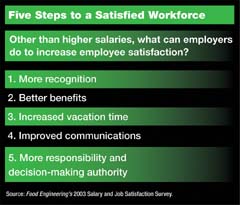
Do more with less
Responsibility for additional projects had the greatest impact on personal workloads, with three out of five respondents indicating increases of that nature. Two out of five cited responsibility for additional operational areas, and a third mentioned reorganization in a department or work group. Staff cuts and management of additional staff also were cited. Only 16 percent indicated they experienced no change in their workload.Just as many companies created new positions (30 percent) as filled vacancies, but those filling vacancies did just that and added no new jobs. Attrition reduced the staffs at 15 percent of respondents' firms, and 23 percent either experienced lay-offs or hiring freezes.
Given a list of 10 possible company actions regarding workloads, 44 percent checked, "Increased production, but added no new positions." Almost as many indicated their employers "directed employees to fill in the gaps." One in five said new positions were created to cope with increased production, and 15 percent indicated manufacturing or packaging had been outsourced. Twenty percent of firms hired a consultant.
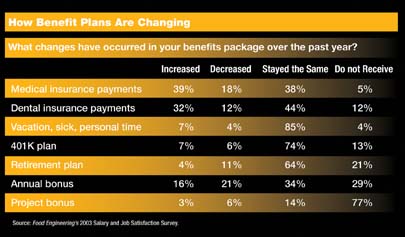
"California economy is in the dumps; decreased sales and increased fixed expenses," one respondent wrote, in the pre-Arnold days. Lack of investment in R&D and plant systems also is a concern, along with poor communication, morale, insurance costs and adequate training.
Gripes about management and food safety concerns were voiced by numerous respondents, but not with the frequency in previous Food Engineering surveys. Food processing is under the same pressures as other manufacturing sectors, but the consensus of readers is that the challenges are understood. Increased sales are the elixir many seek, and attaining them would go a long way toward moving the job satisfaction, security and salary needles in a positive direction.
Looking for a reprint of this article?
From high-res PDFs to custom plaques, order your copy today!


